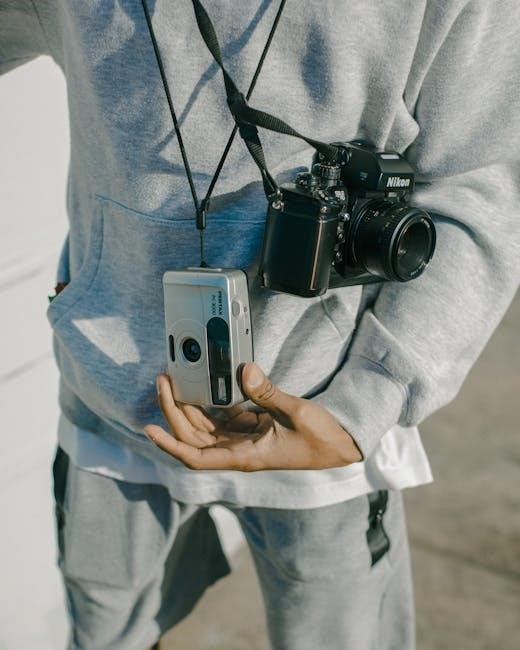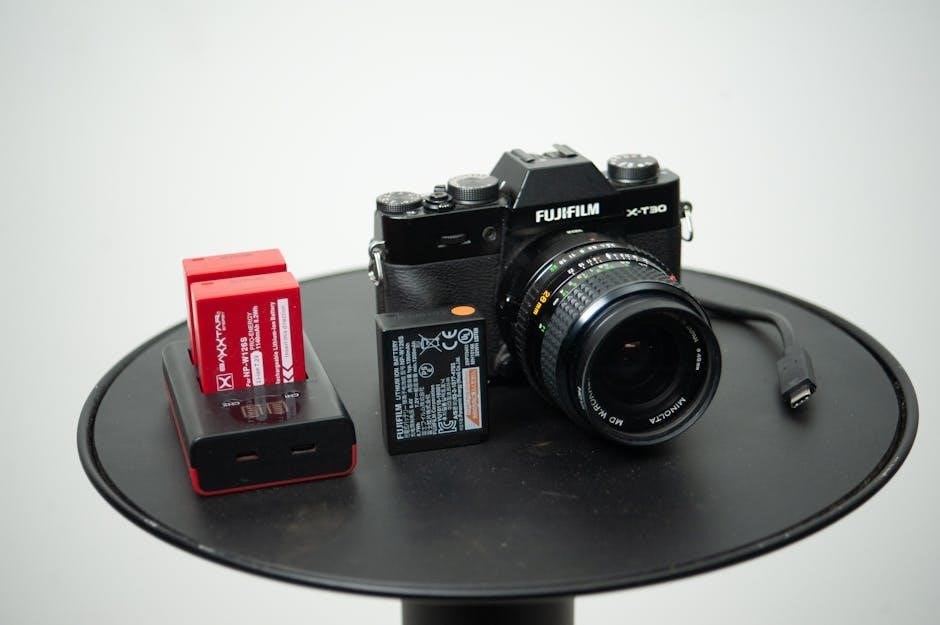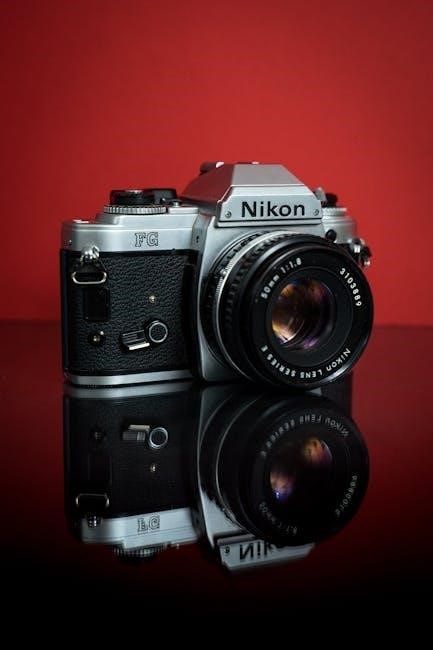The Nikon D3100 is a 14.2-megapixel DSLR camera designed for beginners, featuring a CMOS sensor, 11-point autofocus, and HD video recording capabilities.
1.1 Overview of the Nikon D3100 Camera
The Nikon D3100 is a lightweight, user-friendly DSLR camera featuring a 14.2-megapixel CMOS sensor, ideal for capturing high-quality images with minimal noise. It supports SD, SDHC, and SDXC memory cards, offering versatile storage options. The camera includes an 11-point autofocus system for precise focusing and can record HD videos. Its compact design makes it portable for everyday use. A detailed Spanish manual is available for download, providing guidance on its features and settings. The Nikon Manual Viewer 2 app allows users to access the manual offline on iOS and Android devices, ensuring easy reference anytime.
1.2 Key Features and Benefits
The Nikon D3100 offers a 14.2-megapixel CMOS sensor for high-quality images with low noise; Its 11-point autofocus system ensures quick and precise focusing. The camera supports HD video recording, making it versatile for both stills and video. Compatible with SD, SDHC, and SDXC cards, it provides ample storage flexibility. Lightweight and ergonomic, it’s ideal for everyday use. A free Spanish manual is available for download, while the Nikon Manual Viewer 2 app allows offline access, enhancing usability. These features make the D3100 a great choice for photographers seeking quality and ease of use.

Getting Started with the Nikon D3100
Unboxing the Nikon D3100 reveals a lightweight DSLR with essential accessories. Initial setup involves inserting the battery, memory card, and lens. The manual guides users through configuration.
2.1 Unboxing and First Impressions
Unboxing the Nikon D3100 reveals a lightweight DSLR with a sturdy build. The camera comes with a rechargeable battery, charger, USB cable, and an 18-55mm kit lens. First impressions highlight its ergonomic design, making it comfortable to hold and operate. The 3-inch LCD screen is crisp, and the controls are intuitively placed for easy access. Novice photographers will appreciate the camera’s simplicity and responsiveness. The included manual provides a comprehensive guide to understanding the camera’s features and settings, ensuring a smooth transition into photography.
2.2 Initial Setup and Configuration
Setting up the Nikon D3100 begins with inserting the battery and charging it using the provided charger. Next, install an SD, SDHC, or SDXC memory card to store images. Power on the camera and navigate through the initial setup menu to configure date, time, and language settings. The camera automatically recognizes the lens and memory card. For optimal performance, refer to the Nikon D3100 manual, available for free download in Spanish, which provides detailed instructions for customizing settings and understanding menu options. This ensures a seamless start for capturing high-quality photos and videos.
2.3 Essential Accessories for the Nikon D3100
Essential accessories for the Nikon D3100 include high-capacity SD, SDHC, or SDXC memory cards for storing images and videos. The Nikon Manual Viewer 2 app allows offline manual consultation. An external flash enhances lighting control, while additional Nikon F-mount lenses expand creative possibilities. A sturdy camera bag protects the equipment, and a tripod ensures stability for sharp photos and smooth video recording. These accessories enhance the camera’s functionality and user experience, helping photographers capture high-quality results in various shooting conditions.

Understanding the Camera Components
The Nikon D3100 features a CMOS sensor, 11-point autofocus, and F-mount lens compatibility, ensuring high-quality imaging and versatility for photographers.
3.1 Exterior Parts and Controls
The Nikon D3100 features a lightweight and ergonomic design with intuitive controls. The mode dial on top allows quick access to shooting modes, while the live view button enables video and image preview. The AF and shutter buttons are centrally located for easy operation. The LCD screen provides a clear view of settings and images. Memory card slots and ports are strategically placed for convenience. The camera’s exterior includes essential buttons for menu navigation, ISO, and exposure compensation, making it user-friendly for photographers of all skill levels.
3.2 Interior Components and Sensors
The Nikon D3100 is equipped with a 14.2-megapixel CMOS sensor, designed to deliver high-quality images with minimal noise. It features the EXPEED 2 image processor, enhancing performance and color accuracy. The camera includes an 11-point autofocus system with phase-detection for precise and fast focusing. The sensor supports ISO sensitivity from 100 to 12,800, enabling excellent low-light photography. The interior components also include memory card slots for SD, SDHC, and SDXC cards, ensuring ample storage for photos and videos. These internal features work together to provide a robust imaging system for photographers of all levels.

Camera Modes and Settings
The Nikon D3100 offers multiple shooting modes, including Auto, Scene, and Manual, along with custom settings, providing flexibility for various photography needs and skill levels.
4.1 Auto Mode and Scene Modes
The Nikon D3100 features an intuitive Auto Mode that simplifies photography by automatically adjusting settings for optimal results. Additionally, it offers various Scene Modes, such as Portrait, Landscape, and Close-up, which are designed to enhance specific types of photography. These modes allow users to capture stunning images without manual adjustments, making it ideal for beginners. The camera also supports advanced Scene Modes like Night Portrait and Sports, ensuring versatility in different lighting conditions. With these modes, photographers can achieve professional-looking results effortlessly, leveraging the camera’s built-in intelligence to adapt to various shooting scenarios.
4.2 Manual Mode and Custom Settings
The Nikon D3100 offers Manual Mode for precise control over aperture, shutter speed, and ISO, enabling advanced photographers to tailor settings to their creative vision. Custom Settings allow users to personalize camera functions, such as adjusting autofocus modes or setting default ISO values. These features empower photographers to fine-tune their shooting experience, ensuring optimal results in various lighting conditions. By leveraging Manual Mode and customizing settings, users can unlock the full potential of the D3100, capturing images with greater artistic control and technical precision.
Image Quality and File Formats
The Nikon D3100 delivers high-quality images with its 14.2-megapixel CMOS sensor, supporting both JPEG and RAW file formats for flexibility in post-processing and detail retention.
5.1 Understanding File Formats (JPEG, RAW)
The Nikon D3100 supports two primary file formats: JPEG and RAW. JPEG is a compressed format ideal for sharing and printing, offering smaller file sizes while maintaining quality. RAW, however, stores uncompressed data, capturing maximum detail for post-processing. This format is preferred by professionals for its flexibility in editing exposure, color, and noise reduction. The D3100 allows simultaneous capture of both formats, providing versatility for photographers to choose between convenience and creative control, ensuring optimal results in various shooting scenarios.
5.2 Optimizing Image Quality Settings
To optimize image quality on the Nikon D3100, adjust settings like Image Size and Quality. Choose between JPEG (compressed, smaller files) or RAW (uncompressed, higher detail) based on your needs. For JPEG, select Fine or Basic compression levels. White Balance can be set to Auto or manually adjusted for accurate color representation. Adjust ISO Sensitivity (100-12,800) to minimize noise in low-light conditions. Use Picture Controls to customize color, contrast, and sharpening. Enable Noise Reduction for cleaner high-ISO shots. Properly configuring these settings ensures sharp, vibrant images tailored to your creative vision.

Autofocus and Metering Modes
The Nikon D3100 features an 11-point autofocus system for precise subject tracking and various metering modes, including 3D Color Matrix Metering II, to ensure accurate exposure control.
6.1 Autofocus Modes and Techniques
The Nikon D3100 offers an 11-point autofocus system, providing quick and precise focusing. It features Single Shot AF for stationary subjects and Continuous AF for moving subjects. AF-A automatically switches between modes based on subject movement. The camera also supports Manual Focus (MF) for precise control. Users can select focus points manually or let the camera choose. Techniques like using the center point for accuracy or tracking subjects with 3D Tracking AF enhance focusing efficiency. The AE-L/AF-L button allows locking focus and exposure, ensuring sharp images in various lighting conditions. Proper use of these modes and techniques optimizes autofocus performance for professional results.
6.2 Metering Modes and Exposure Control
The Nikon D3100 features a 3D Color Matrix Metering II system, providing accurate exposure control. It offers three metering modes: Matrix Metering, which analyzes the entire scene; Center-Weighted Metering, focusing on the central area; and Spot Metering, measuring light from a small spot. Users can adjust exposure compensation (+/-5 EV) to fine-tune brightness. The AE-L/AF-L button locks exposure and focus, ensuring consistency in challenging lighting conditions. Proper use of these modes and controls enables precise exposure management, enhancing the quality of images captured with the Nikon D3100.

Flash and Lighting
The Nikon D3100 features a built-in flash for low-light situations and supports external flash units for advanced lighting control. It also emphasizes the use of natural light and external lighting for optimal results.
7.1 Built-in Flash and External Flash Options
The Nikon D3100 features a built-in flash for convenient low-light photography. It automatically pops up and fires when needed but can also be manually activated. The built-in flash is ideal for casual shooting and provides enough power for small spaces. For more advanced lighting, the camera supports external flash units, such as Nikon’s Speedlight series, offering greater control over light direction and intensity. External flashes can be mounted on the hot shoe or triggered wirelessly, allowing for creative lighting setups. This flexibility makes the D3100 versatile for both beginners and enthusiasts exploring flash photography.
7.2 Using Natural Light and External Lighting
Maximizing natural light is essential for capturing high-quality images with the Nikon D3100. Shoot near windows or outdoors during the golden hour for soft, warm tones. Overcast skies provide diffused light, reducing harsh shadows. For external lighting, the D3100 supports the use of Speedlight flash units, which can be mounted on the hot shoe or triggered wirelessly. These flashes offer advanced control over lighting direction and intensity, ideal for portraits or low-light scenarios. Combining natural and external lighting techniques enhances creativity and ensures well-lit, professional-looking photos, making the D3100 versatile for both casual and advanced photographers.

Video Recording and Playback
The Nikon D3100 records HD video at 1080p/24fps, offering full-time servo AF for smooth focus tracking. Playback features include HDMI output for external displays and basic in-camera editing options.
8.1 Video Modes and Settings
The Nikon D3100 offers HD video recording at 1080p/24fps, providing a cinematic look. It supports frame rates of 24, 25, and 30fps, catering to different shooting styles. The camera features a dedicated movie button for quick access and allows manual focus during filming for precise control. Additionally, the D3100 supports external microphone input, enhancing audio quality for videographers. These modes and settings make it versatile for capturing high-quality video content, ideal for both beginners and enthusiasts exploring filmmaking with a DSLR.
8.2 Playback and Editing Options
The Nikon D3100 features a 3-inch LCD screen for reviewing photos and videos. During playback, users can zoom in on images, delete unwanted shots, and view shooting data. The camera also allows basic editing of images directly on the device, such as adjusting brightness and contrast. For video, the D3100 offers in-camera movie editing options, including trimming clips to desired lengths. Additionally, the camera supports transfer of files to a computer for further editing using Nikon software like ViewNX or external programs like Adobe Lightroom.

Maintenance and Troubleshooting
Regularly clean the camera sensor and exterior to maintain performance. Check firmware updates for the latest features. Use Nikon Manual Viewer 2 for troubleshooting common issues and solutions.
9.1 Cleaning and Maintaining the Camera
Regular maintenance ensures optimal performance of the Nikon D3100. Clean the sensor gently with a soft brush or blower to remove dust. Use a microfiber cloth to wipe the exterior and lens. Avoid harsh chemicals. Check for firmware updates via the Nikon website to keep your camera up-to-date. For detailed cleaning instructions, refer to the Nikon D3100 manual or use the Nikon Manual Viewer 2 app for guidance. Proper care extends the life and functionality of your camera, ensuring high-quality images and smooth operation.
9.2 Common Issues and Troubleshooting
Common issues with the Nikon D3100 include error messages like “CARD NOT FORMATTED” or “MEMORY CARD ERROR,” often resolved by formatting the card in-camera. Lens errors may occur due to improper attachment; ensure the lens is securely mounted. Battery issues can arise from low charge or faulty contacts; clean contacts with a soft cloth. For firmware-related problems, update to the latest version via Nikon’s website. Consult the Nikon D3100 manual or Nikon Manual Viewer 2 app for detailed troubleshooting steps. Addressing these issues promptly ensures uninterrupted photography and optimal camera performance.

Advanced Techniques and Tips
Master RAW image capture, manual focus precision, and custom settings to elevate your photography. Experiment with creative modes and techniques for stunning results with the Nikon D3100.
10.1 Advanced Shooting Techniques
Master advanced shooting techniques with the Nikon D3100 to enhance your photography. Capture stunning images using RAW format for greater flexibility in post-processing. Utilize manual focus for precise control, especially in low-light conditions. Experiment with the camera’s HD video recording capabilities to create compelling stories. Take advantage of the Continuous Shooting mode to freeze fast-moving subjects. Adjust ISO settings carefully to balance noise and exposure. Explore the use of custom white balance for accurate color representation. Practice panning and long exposures to add creative effects to your shots. These techniques will help you unlock the full potential of your Nikon D3100.
10.2 Customizing the Camera for Personal Use
Customize your Nikon D3100 to suit your photography style. Adjust autofocus modes, metering modes, and custom menu options for personalized control. Assign frequently used functions to specific buttons for quick access. Set default image settings like white balance and ISO to match your shooting preferences. Explore custom autofocus points for precise subject tracking. Utilize the camera’s customization options to streamline your workflow and enhance your creative process. These features allow you to tailor the D3100 to your needs, ensuring a more intuitive and efficient shooting experience.

Accessories and Upgrades
Enhance your Nikon D3100 with compatible lenses, external flash units, and tripods for improved stability and creativity. Use memory cards like SD, SDHC, or SDXC for storage. Download the Nikon Manual Viewer 2 app for offline manual access and firmware updates to keep your camera optimized.
11.1 Recommended Lenses and Accessories
To maximize your Nikon D3100’s potential, consider pairing it with high-quality AF-S DX NIKKOR lenses, such as the 18-55mm kit lens or 55-200mm zoom for versatility. Prime lenses like the 35mm or 50mm f/1.8 are ideal for portraits. A tripod ensures stability, while an external flash enhances lighting control. Memory cards (SD, SDHC, or SDXC) provide ample storage. Additionally, a camera bag, remote shutter release, and Nikkor cleaning kit are essential for maintenance and convenience. The Nikon Manual Viewer 2 app offers offline manual access, ensuring you always have guidance at hand.
11.2 Upgrading Firmware and Software
Regular firmware and software updates ensure optimal performance of your Nikon D3100. Visit Nikon’s official website to check for the latest firmware versions. Download the update to a memory card and follow on-camera instructions for installation. Always use a fully charged battery and avoid interruptions during the process. Additionally, update software like Nikon Transfer or ViewNX for enhanced compatibility and features. These updates often improve functionality, fix bugs, and support new accessories. Keep your camera and software up-to-date for the best user experience and to access all available features effectively.
The Nikon D3100 is a versatile DSLR camera ideal for beginners, offering excellent image quality, intuitive controls, and essential features for capturing memorable moments effortlessly.
12.1 Final Thoughts on the Nikon D3100
The Nikon D3100 remains a popular choice for photography enthusiasts, offering a perfect blend of simplicity and advanced features. Its 14.2-megapixel CMOS sensor delivers crisp images, while the 11-point autofocus ensures sharp results. The camera’s lightweight design and intuitive controls make it ideal for beginners and casual shooters. With HD video recording and scene modes, it adapts to various creative needs. The availability of a comprehensive Spanish manual further enhances accessibility. Overall, the D3100 is a reliable and versatile DSLR that continues to satisfy photographers seeking quality and ease of use.
12.2 Resources for Further Learning
For deeper understanding, the Nikon Manual Viewer 2 app offers offline access to the D3100 manual on iOS and Android devices. Nikon’s official website provides downloadable manuals, software, and firmware updates. Additionally, the Spanish manual for the D3100 is available at manuall.es, along with user guides and FAQs. These resources ensure comprehensive learning and troubleshooting, helping users master the camera’s features and settings for optimal photography experiences.



